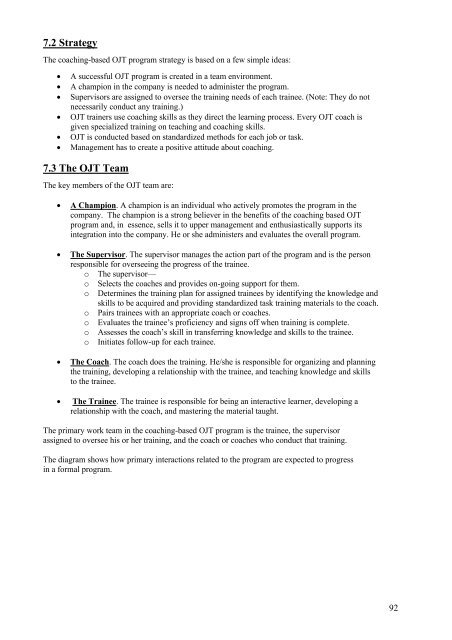How to Perform On-the-job Training - Dean Amory
According to The Encyclopedia of Business, ©2000 Gale Cengage, On-the-job training is by far the predominant form of job training. Studies also indicate that it is the most effective form of job training. Yet, it also represents a significant investment considering that roughly 30% of a new worker's time is spent in on-the-job training during the first 90 days of employment, that productivity of experienced workers assigned to train new workers may decrease during the training period, and that new workers may make expensive mistakes. Both companies and workers therefore profit largely from the presence of simple, but complete trainee and trainer guides that allow for executing OJT in a structured way. “How to perform on-the-job training”, has the information, techniques and tips that will allow you to implement a professional OJT training program. The book also includes all the tools, documents and checklists necessary for setting up a qualitative and efficient skills training program for OJT coaches
According to The Encyclopedia of Business, ©2000 Gale Cengage, On-the-job training is by far the predominant form of job training. Studies also indicate that it is the most effective form of job training. Yet, it also represents a significant investment considering that roughly 30% of a new worker's time is spent in on-the-job training during the first 90 days of employment, that productivity of experienced workers assigned to train new workers may decrease during the training period, and that new workers may make expensive mistakes.
Both companies and workers therefore profit largely from the presence of simple, but complete trainee and trainer guides that allow for executing OJT in a structured way.
“How to perform on-the-job training”, has the information, techniques and tips that will allow you to implement a professional OJT training program. The book also includes all the tools, documents and checklists necessary for setting up a qualitative and efficient skills training program for OJT coaches
Create successful ePaper yourself
Turn your PDF publications into a flip-book with our unique Google optimized e-Paper software.
7.2 Strategy<br />
The coaching-based OJT program strategy is based on a few simple ideas:<br />
A successful OJT program is created in a team environment.<br />
A champion in <strong>the</strong> company is needed <strong>to</strong> administer <strong>the</strong> program.<br />
Supervisors are assigned <strong>to</strong> oversee <strong>the</strong> training needs of each trainee. (Note: They do not<br />
necessarily conduct any training.)<br />
OJT trainers use coaching skills as <strong>the</strong>y direct <strong>the</strong> learning process. Every OJT coach is<br />
given specialized training on teaching and coaching skills.<br />
OJT is conducted based on standardized methods for each <strong>job</strong> or task.<br />
Management has <strong>to</strong> create a positive attitude about coaching.<br />
7.3 The OJT Team<br />
The key members of <strong>the</strong> OJT team are:<br />
A Champion. A champion is an individual who actively promotes <strong>the</strong> program in <strong>the</strong><br />
company. The champion is a strong believer in <strong>the</strong> benefits of <strong>the</strong> coaching based OJT<br />
program and, in essence, sells it <strong>to</strong> upper management and enthusiastically supports its<br />
integration in<strong>to</strong> <strong>the</strong> company. He or she administers and evaluates <strong>the</strong> overall program.<br />
The Supervisor. The supervisor manages <strong>the</strong> action part of <strong>the</strong> program and is <strong>the</strong> person<br />
responsible for overseeing <strong>the</strong> progress of <strong>the</strong> trainee.<br />
o The supervisor—<br />
o Selects <strong>the</strong> coaches and provides on-going support for <strong>the</strong>m.<br />
o Determines <strong>the</strong> training plan for assigned trainees by identifying <strong>the</strong> knowledge and<br />
skills <strong>to</strong> be acquired and providing standardized task training materials <strong>to</strong> <strong>the</strong> coach.<br />
o Pairs trainees with an appropriate coach or coaches.<br />
o Evaluates <strong>the</strong> trainee’s proficiency and signs off when training is complete.<br />
o Assesses <strong>the</strong> coach’s skill in transferring knowledge and skills <strong>to</strong> <strong>the</strong> trainee.<br />
o Initiates follow-up for each trainee.<br />
The Coach. The coach does <strong>the</strong> training. He/she is responsible for organizing and planning<br />
<strong>the</strong> training, developing a relationship with <strong>the</strong> trainee, and teaching knowledge and skills<br />
<strong>to</strong> <strong>the</strong> trainee.<br />
The Trainee. The trainee is responsible for being an interactive learner, developing a<br />
relationship with <strong>the</strong> coach, and mastering <strong>the</strong> material taught.<br />
The primary work team in <strong>the</strong> coaching-based OJT program is <strong>the</strong> trainee, <strong>the</strong> supervisor<br />
assigned <strong>to</strong> oversee his or her training, and <strong>the</strong> coach or coaches who conduct that training.<br />
The diagram shows how primary interactions related <strong>to</strong> <strong>the</strong> program are expected <strong>to</strong> progress<br />
in a formal program.<br />
92


















